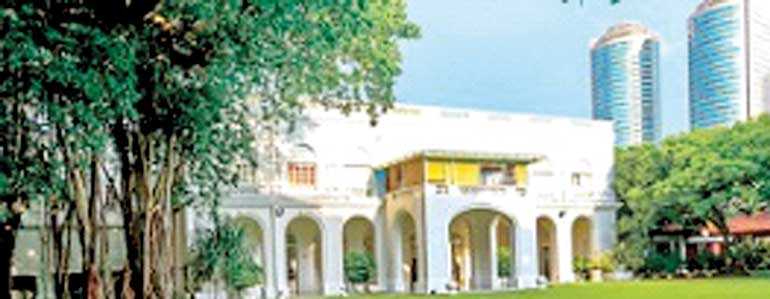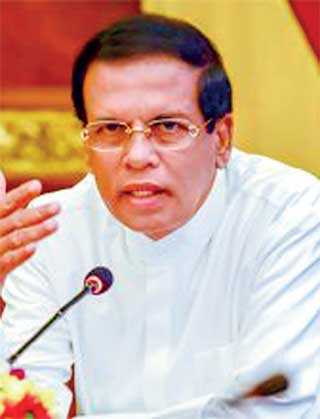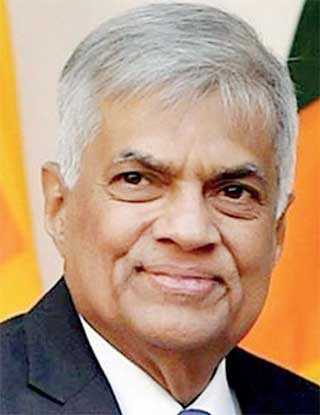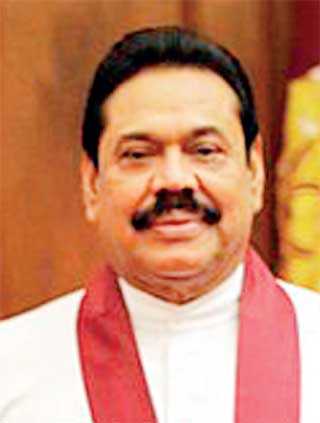Wednesday Jan 07, 2026
Wednesday Jan 07, 2026
Tuesday, 6 August 2019 00:18 - - {{hitsCtrl.values.hits}}
The next Presidential Election is around the corner, but the principal parties are yet to announce their candidates, with infighting within the parties. Meanwhile, a number of candidates are canvassing, without openly claiming their candidature. A few others too have declared their intentions. But the basic issue remains: Are the prospective candidates aware of country’s problems and will they publicise their solutions to enable voters to select a leader capable of solving the problems and develop the country? The next president will need to rectify the blunders of the current Government and address issues facing the country.
Blunders of current Government
The current Government is responsible for the most number of blunders of any government since independence. Prospective candidates need to understand blunders in-depth to find solutions to problems. Some of them are:
Colombo Port City 
Immediately after the Presidential Elections in 2015, the UNP suspended further construction of Port City being built by the Chinese, but was forced to recommence after one year, when the Government realised the possible liability of $ 190 million due to the Chinese developer if the Port City was abandoned.
The legislation confirming Port City as a part of Sri Lanka was accepted by the Parliament at the end of last month. The filling of Port City was completed by February 2018 and the legislation took nearly 18 months. If the legislation was brought promptly, construction works of the Financial City could have commenced a year ago.
Hambantota Port
The UNP had been against the Hambantota Port constructed by the Rajapaksa Government. Having assumed power, the new Government faced payment of $ 1.1 billion for construction costs and was forced to sign the Port sharing agreement with Chinese in July 2017.
Under the agreement, in addition to the Port, 15,000 acres of land around the Port were to be released to build an industrial zone, but the land was not released to be developed and lies idling, unused for any purpose. If the large acreage was released as agreed, when China relocated a large number of its industries in other countries to overcome US President Trump’s heavy taxes over Chinese goods, a number of Chinese factories would have been established in Hambantota, giving employment to locals, also activating cargo handling in Hambantota Port, import of raw materials and export of finished products. In addition frequent flights between Mattala and China would have reactivated Mattala Airport.
Moragahakanda project
The project was expected to deliver water to the arid north, but was modified after winning the war by the Rajapaksa Government, which was against giving water to Tamils. President Sirisena, who was involved with the Moragahakanda scheme since 2007 as the Minister in Charge, was only interested in issuing water to Polonnaruwa. Having completed Moragahakanda reservoir in 2017 January, stored water was released exactly a year later. On the same day he commenced the construction of the canal to carry stored water northwards.
He may not have been aware that when President J.R. Jayewardene in 1977 inaugurated building Victoria, Randenigala and Rantembe dams and the Right Bank Channel to carry waters to Maduru Oya reservoir, during the construction period itself, farmers were settled under Ulhitiya and Ratkinda reservoirs along the way, all within seven years. Sirisena plans to complete the entire Moragahakanda project by 2034, in 17 years. Meanwhile, Moragahakanda waters will not be fully utilised. Continuing with Rajapaksa-modified proposals only shows his ignorance and carelessness of in-depth analysis over his pet project.

Kandy Expressway
– A series of blunders
The construction of the Kandy Expressway was re-inaugurated by the Prime Minister Ranil at Kossinna in August 2015. The public was informed that the first section 32.5km-long Kossinna to Mirigama sector would be constructed by Metallurgical Corporation of China. The PM expected the five-km-long Kadawatha to Kosssina stretch could be covered with savings of Kadawatha-Enderamulla sector which was awarded earlier, but the current Government reduced the scope, by bringing back the commencement of the highway to original Kadawatha. But the RDA engineers failed to get the contractor to agree.
 |
President Maithripala Sirisena |
 |
Prime Minister Ranil Wickremesinghe |
 |
Former President Mahinda Rajapaksa |
Kandy highway was previously offered to international investors in May 2011, to be built as a four-lane privately-financed toll road on BOT (build, own & transfer) basis. Phase 1, Kadawatha-Ambepussa sector and Phase 2, Ambepussa-Devalagama to Katugastota, with a connecting link to Gannoruwa, a total length 98.9km. A Chinese contractor agreed to construct the Phase I for a 35-year BOT period with construction beginning in August 2012, the second sector Ambepussa-Kandy requiring a longer period.
But in July 2012 the Government decided to shift the commencement from Kadawatha to Enderamulla, increasing the highway distance by 5kms. In addition marshes around Enderamulla necessitated nine km of viaducts (overhead bridges), increasing costs, and the Chinese investor was no longer interested.
In addition, Mahinda Rajapaksa, in March 2013, directed the expressway be built through Kurunegala and Galagedara as requested by local politicians. With this diversion highway distance to Kandy, the most travelled road in the country, length increased by 22kms over the current A1 road, costing over Rs. 5 billion per km. What Ranil attempted in August 2015 was to part correct the blunder made in July 2012. But negotiations with the contractor failed and after four years the construction of the five km section is yet to begin. Ranil also failed to correct the Rajapaksas’ blunder which increased the Kandy route by 22km back to the original route. Had the original Chinese offer been accepted, a 22km shorter highway to Kandy would have been operational years ago, without burdening the country’s budget.
Power generation blunder
The country is facing the worst power supply situation in its history, as the current Government failed to get even a single major power generation plant established or even awarded for construction. After electrical power broke down in March, Ravi Karunanayake, the Minister for Power and Energy, proposed and the Cabinet accepted establishing four coal power plants.
But most countries in the world have agreed not to establish any more coal-based power plants after 2020 due to pollution. Even India, with own coal resources and power plant technology, has been closing down coal power plants. With the full utilisation of hydro-power, the country needs a firm base-power and LNG is the only environmentally friendly power source. Also Mannar gas discovered in 2011 remains without any plans or will for utilisation. Meanwhile, over 70% of electricity generation continues to be based on coal and diesel.
Coal power costs around Rs. 17.50 per unit and diesel power beyond Rs. 25 a unit, in addition to be most polluting. Meanwhile in the tender for 300MW LNG power plant, Lakdhanavi (a local company owned by CEB) offered power less than Rs. 15 a unit, but the President wishes to award the tender to a Chinese supplier at a higher price and awarded two contracts to both at different prices. The matter is pending in Court.
Sri Lanka has no experience in using LNG, nor has it made any plans to acquire technology, also establishing unloading and storage facilities, basic requirements for harvesting Mannar gas. Meanwhile, Lakdhanavi already runs a 300MW power-plant in Kerawalapitiya, capable of running on LNG but on diesel at a higher price. The same company operates three power plants in Bangladesh. The Government or the politicians for their own reasons are reluctant to use the local contractor for improvement of the sector and getting the knowhow.
Meanwhile the Cabinet accepted purchasing 200MW of barge-mounted emergency power. But it was reported that Attorney General is against the award without calling for tenders.
High cost of Government
The country is facing a severe financial crisis with almost 90% of Government revenue being spent on debt servicing; the Government is forced to get loans locally and abroad for day-to-day expenses.
The country is burdened with extremely expensive political structure, vast Government administrative system without productive use, but keeps on expanding. The current Government’s ‘White July’ program offers additional handouts prior to elections. The next government will have to foot the bill.
Meanwhile, Ranil is proposing a new coalition which will increase ministerial numbers to 48 and also junior ministers, without concern of expenses.
Education going downhill
With the conversion of the medium of instruction to Sinhala/Tamil in 1956, education standards crashed and educated youth were unable to find employment, resulting in the 1971 riots. With the JVP riots in 1988/’89 disturbing education for a long period, it resulted in private English medium education institutes under international schools. Chandrika Bandaranaike in 1995 introduced English medium in schools, but subsequent governments failed to supply teachers, resulting in only few schools offering an English stream.
Most surprising was the attempt by the current Government to abolish private English medium schools by the Ministry of Education Secretary’s circular, that schools should teach either in the mother tongue (Sinhala/Tamil) or in bilingual medium, in terms of the Education Policy of the Government. The circular was challenged in the Supreme Court and the Court rejected the circular. The Court also declared that according to the National Education Commission Act, the President is expected to declare the National Education Policy, but none of the past presidents have declared such a policy.
Poor education in universities has resulted in most graduates being jobless and the current Government is expecting to absorb 16,500 jobless graduates as management assistants although there is no such position in the cadre. Finding finances to pay the salaries would also be an issue.
Prime Minister’s gifts to people
Some time ago Ranil Wickremesinghe wished everyone to have gold bracelets. Prior to elections he promised Wi-Fi to every village. Recently he wished to issue every student a computer tab, which was cut down by the President as only to A/L students in selected schools. No one questioned how the children would use tabs without English.
According to Ranil the tabs would be modified so that students would not misuse them. But with our local IT technicians’ capabilities, within a week of issue, they would modify the tab to visit any site on internet. Now the PM wishes to give every village a set of body-building kits. It is unfortunate that the PM continuously fails to understand ground level realities.
President’s travels
A major allegation against Mahinda Rajapaksa during his presidency was his usage of SriLankan Airlines for travels around the world with massive entourages. President Sirisena beats his predecessor way ahead with his number of trips around the world, over the simplest of excuses, accompanied by around 50 persons. But when he wished to travel to Canada, the Canadian Government refused to accommodate, thus Sirisena missed seeing Niagara Falls.
The President is the most important executive in the country. He is expected to read, understand and approve every project, Cabinet paper and proposal. In conflicting matters and on subjects beyond his knowledge, he is expected to listen to different experts and make his own judgement. Thus his time management is most important. President Sirisena’s countrywide visits are shown on TV news practically every day. When he accepts every petty invitation nationwide, he sacrifices time for important work.
The President’s outstation visits are generally by helicopter, but from the landing point to function location in a bullet-proof vehicle brought from Colombo on a trailer. Hundreds of Police and forces are called upon to provide local security, intelligence officers investigate days in advance of any threats. Recently, he got down two more bulletproof vehicles costing Rs. 190 million. The occupation of intelligence officers on President’s security and over drug issues is a major reason of intelligence failure of being vigilant on Easter Sunday threat.
When the Easter bomb attacks took place, Ranil was relaxing in Galle over the weekend as usual and rushed to Colombo by 10 a.m., but members of the Security Council refused to meet him, claiming he had no authority.
Meanwhile, President Sirisena soon after the Sinhala New Year visited Thirupathi with the family and was in Singapore during the Easter attacks. According to his Parliament speech he was informed of the attack at 10 a.m. As Singapore time is two-and-a-half hours ahead, meaning 7:30 a.m. Sri Lanka time, ahead of the attack. If 10 was Singapore time, why was the delay in informing the President who also was the Commander-in-Chief?
After the news of the attack the President had lunch with his family and continued shopping for his son’s wedding. To return he took the midnight flight from Singapore, but there were two other SriLankan flights earlier. His speeches afterwards of news of warnings and his actions were full of contradictions. Was his trip abroad planned after intelligence reports of possible attacks, of which the President thought he might be the possible target?
President’s tree planting
World Environment Day fell on 6 June and the President planted a sapling at the BMICH and launched the tree planting program. At the function, President Sirisena informed that he would ban the import of chainsaws used for felling trees. He also promised not to allow opening of new carpentry sheds and close down sawmills in five years.
Most Sri Lankans are unaware of the famous banyan tree, a historic landmark at the President’s House or the former Queen’s House in Fort. The tree was planted by then Governor Sir Joseph West Ridgeway on 18 June 1862, to honour the 25th anniversary of Queen Victoria at the throne.
Late Lakshman Kadirgamar recalled a meeting with US Secretary of State Colin Powell soon after the ethnic disturbances of July 1983. General Powell, speaking of his memories of Sri Lanka, had recalled that what he cherished most was the sight of the banyan tree, when he held a meeting with President J.R. Jayewardene. Upon return to Sri Lanka,
Kadirgamar sent Gen. Powell an autographed copy of a large size photograph of the historic tree with a narrative on the tree’s history written by the Head of the Botanical Gardens. But the famous historic banyan tree in President’s House disappeared in November 2017, while President Sirisena was in power.
Ranil’s affection towards US
During the premiership Ranil displayed his affection towards US and the West.
He stopped construction of Port City and Hambantota Port by Chinese, expecting the US to come to his rescue. But nothing happened. Non-handing over of Hambantota Port lands for industrial purposes was another blunder to please the West.
His biggest blunder was the co-sponsoring of the US-created resolution titled ‘Promoting reconciliation, accountability and human rights in Sri Lanka’ in October 2015 at United Nations.
The resolution was on causing the deaths of 45,000 Tamil civilians during the ending stage of the war with LTTE. But according to British Government sources the death numbers were only 8,000. The exaggerated numbers were a creation of Tamil staff employed by the US Embassy in Colombo. But why did the Sri Lankan Government accept hugely-exaggerated numbers of the US Government?
Housing and Samurdhi to poor
The current Government offered Samurdhi to 150,000 new families just before elections. Did so many families become poorer due to the Government’s failed policies? In addition Sajith Premadasa goes around the country opening up villages with around 25 houses for poor families almost every day.
But how were the recipients selected, was there a survey identifying the deserving? How about the houses they occupied earlier? Were they employed, can they continue same employment or own agriculture from the new location? If proper answers cannot be given, the housing program would be utter failure and waste of valuable Government money, including massive function costs, serving only political purposes.
Failure of Yahapalanaya Government
The current Government during its term failed to commence even a single large project on its own. Started projects were planned by the previous regime, but were not analysed for their viability, Moragahakanda and Kandy Expressway among them. The Government also failed to address the electrical power crisis.
Presidential candidates for the next election need to understand the current situation to take the country forward. Suggested solutions are given in the second section of the article.
Part 2 tomorrow